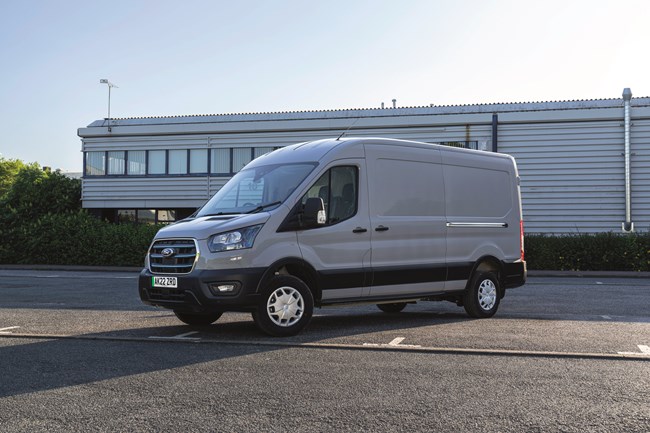- ETRUX launches new Ford E-Transit Trizone
- Renault gives UK debut to Master E-Tech at CV Show
- Isuzu D-Max long-term test – Latest Report
- Isuzu D-Max V-Cross Steel Edition revealed
- IVOTY Report: Stellantis explores the hydrogen proposition
- New Maxus EVs include eDeliver 5 van
- Used LCV values reach six-month high
- ADVERTISEMENT FEATURE: IVECO Daily Mission Awards 2024 Q2 Round-up: Grounds Maintenance & Forestry
- Stellantis Pro One electric vans review
- Mitie adds 5,000th EV to fleet
What Van? Awards 2023: Van of the Year – Ford E-Transit
Date: Friday, December 16, 2022

Ford may have bided its time before joining the electric van revolution but the wait was worth it. The E-Transit raises the bar across the board for large electric vans.
Ford unveiled the electric version of its iconic large van at the end of 2020 and at the same time announced a raft of future upgrades to its suite of fleet management tools to support the newcomer’s pending arrival.
Among the new features offered by Ford Commercial Solutions are electric vehicle tools, allowing fleet managers to monitor the performance of individual vans with data such as energy consumption, charge speed and remaining driving range.
The manufacturer then undertook customer trials of the van in 2021 to allow its engineers to gather data to refine the E-Transit’s connected vehicle and range management features.
When the E-Transit came to market in the Spring of 2022 it was clear the meticulous preparation had paid off.
A 196-mile range is perhaps the biggest headline accompanying the E-Transit, making it a viable option for customers who need it for inter-city, as well as just inner-city missions.
Then there is the startling £42,000 (excluding VAT and the PiVG) starting price, which significantly undercuts its rivals and puts the E-Transit within reach of customers who may otherwise have considered a large electric van, or a fleet of large electric vans, beyond the reach of their businesses’ budgets. Next up is the power – a 198kW electric motor producing a blistering 265hp and 430Nm of torque.
But the E-Transit is seemingly the gift that keeps on giving because Ford launched the model in the Spring with 25 variants, including short, medium and long-wheelbase panel vans with two roof heights. There are also three gross vehicle weights to choose from, so you can have an E-Transit van at 3.5t, 3.9t or 4.25t, giving you a maximum payload of up to 1,758kg for the panel van models and 2,090kg for a chassis cab.
It’s by far the most complete line-up of any electric van currently on sale and was the most eagerly anticipated vehicle of the year.
As well as a 198kW motor, the E-Transit will also be available with a 135kW option – a less terrifying option for fleet managers who may be reluctant to give their drivers 265hp and will be more comfortable with the 181hp from the smaller motor. Despite nearly one third less power, it’s still a fast van not least because it retains the same amount of torque. That makes the E-Transit exceptionally eager to get off the line and with no gears to change it’s relentless in building speed.
The 68kWh battery is bolted underneath the chassis of the van in a heavily protected casing, which lowers the centre of gravity even further than in other electric vans that tend to have the batteries squeezed in between the chassis rails. As a result, the E-Transit feels even more planted to the ground and the already responsive handling of the diesel van is improved upon further still.
Power is through the rear wheels, which is where the motor is located within the axle. The resulting construction is sizeable and has forced Ford to re-engineer the rear suspension, placing the new independent coil springs away from the chassis.
Another remarkable characteristic of the E-Transit is how quiet it is to drive. Electric vans are always quiet, of course, but by installing the motor in the rear of the van there’s now a long way between the driver and the most obvious source of noise.
There is little intrusive wind or road noise around the front of the vehicle either, which makes the overall driving experience a relaxing one.
There has to be a pay off for the rear-wheel drive configuration, however, and it is that the load deck height for rear-wheel Transits is higher than other large vans. Given that these vans will likely find their way onto fleets initially, with home delivery and courier companies appearing to be the early adopters of electric vans, the additional 100mm from ground level to the floor compared to the diesel version is not insignificant.
When it comes to the inside of the cab, the E-Transit is similar to the regular Transit with one major and noticeable difference – a large 12in infotainment screen that runs Ford’s latest Sync 4 system. The screen shows all the usual infotainment related items, wireless smartphone pairing, as well as being the brains behind the van’s integration with the FordLiive uptime tracking system and Ford Pass Pro enabling vehicle pre-conditioning, remote start, charging schedules and location. SYNC 4 will also get regular over-the-air, wireless software updates keeping the system current and up-to-date. More importantly the screen along with the digital display in the dash cluster shows information about the van’s driving modes, power consumption and battery status with an intelligent range predictor to give drivers a more accurate estimate of their range based on driving style, weather and traffic.
There are two different levels of regenerative braking and three driving modes to choose from with the braking controlled either via a button within the gear selection rotary dial or by using the brake pedal.
A standard charge from a three-phase 11.3kW wall box will take eight hours, but rapid charging on a 115kW charger allows a top-up from 15% to 80% in 34 minutes.
View The WhatVan Digital Edition


